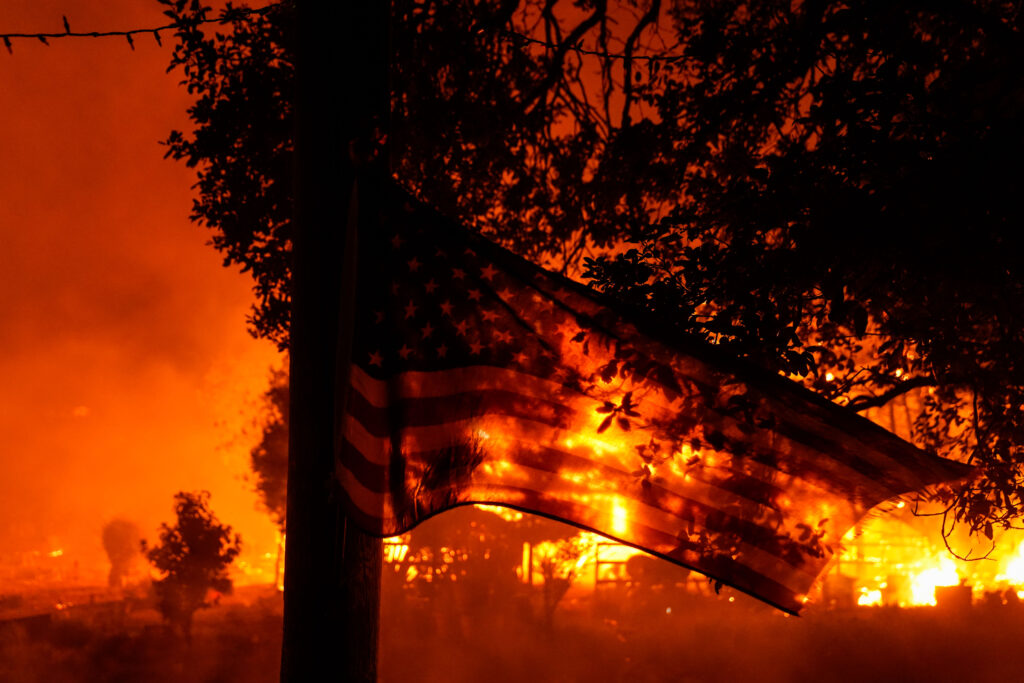Interviews / Climate, Environment, Security
23 January 2025
Wildfires in Los Angeles: How to Adapt to Climate Change?

The Los Angeles region has been devastated since January 7 by massive wildfires, causing significant human, material, and economic damage—unprecedented in California’s history. These destructive wildfires follow those that have ravaged Australia, Canada, France, and Chile in recent years, with their frequency and intensity symptomatic of the disruptions caused by climate change. What explains the scale of the fires in Los Angeles? What are their consequences? How have authorities responded? And how can we address the growing number of wildfires on a global scale? Answers from Mathilde Jourde, a researcher at IRIS within the Climate, Energy, and Security Program.
Violent wildfires have been ravaging the Los Angeles region for over a week. What were the main climatic factors behind these fires?
Contrary to misinformation propagated by Donald Trump and amplified on social media regarding the deadly (28 deaths) and devastating fires still raging in parts of California since January 7, the severity of these rare winter fires is primarily the result of environmental factors exacerbated by human activity.
While wildfires in winter are not entirely uncommon in California, this season is generally less favorable for such events. However, several converging elements have intensified these specific fires. First and foremost, the Santa Ana winds, which are hot and dry and characteristic of winter months, played a crucial role. These winds reached exceptional speeds, with gusts peaking at 160 km/h (100 mph), allowing ashes and sparks to spread over vast distances, sparking multiple new fires. Additionally, unusually high temperatures for early winter, combined with a particularly dry January—normally a rainy month in California—created conditions highly conducive to wildfires. The combination of a windy season and an abnormally dry period partially explains the intensity of these fires.
Human factors have also worsened the situation. Climate change, in particular, has amplified the severity of the wildfires. A lesser-known phenomenon, known as “hydroclimatic whiplash”, also played a critical role. This phenomenon refers to the alternation between particularly wet and dry periods. In California’s case, the rainy winters of 2023 and 2024 encouraged the growth of dense vegetation. However, the lack of precipitation during the fall of 2024 and winter of 2025 turned this dry vegetation into ideal fuel for fires. According to climatologist Daniel Swain, this phenomenon, which has significantly increased wildfire risks in the region, is expected to become more frequent as the effects of climate change intensify.
Finally, urbanization and the sprawl of Los Angeles have heightened the city’s vulnerability to wildfires. Many homes in Los Angeles are located amidst or adjacent to the local vegetation, the chaparral, which is highly flammable and prone to fires. Furthermore, the flammable materials used in the construction of these homes make them even more susceptible to these devastating wildfires.
What were the consequences of these wildfires? What responses were provided by local authorities and the U.S. government?
The Los Angeles wildfire has caused catastrophic social and environmental consequences: 28 deaths, over 180,000 displaced people, and more than 10,000 buildings destroyed. A total of 16,000 hectares of vegetation in both urban and mountainous areas were devastated. Beyond human losses and direct environmental impacts, other less visible consequences have also emerged. The air was heavily contaminated with atmospheric pollutants. Burned infrastructure released substances such as asbestos, copper, and lead, posing significant health risks to the population. Water supplies were also contaminated, both through air pollution and damage to water infrastructure. For instance, the intense heat melted plastic pipes and water meters, releasing hazardous chemicals into the water system.
The fires also inflicted heavy economic losses, estimated at over $150 billion, potentially making this the most costly wildfire in modern Californian and even U.S. history. Further economic consequences are expected for the insurance industry. Over the past two years, companies like State Farm and Allstate have suspended or limited coverage in California due to the high risks posed by wildfires, winter storms, and earthquakes. This wildfire could exacerbate the ongoing insurance crisis, pushing some companies to adopt new withdrawal strategies. Its location, at the heart of a major urban area and in affluent residential neighborhoods, has resulted in insured losses estimated at around $20 billion. As California becomes an increasingly high-risk market, it also becomes less profitable for insurance companies, making coverage increasingly unsustainable.
The wildfire has also had significant political consequences, particularly through its exploitation for partisan purposes. The Republican camp has extensively used misinformation and fake news to weaken California’s Democratic political leaders and redirect public anger toward them. For example, Donald Trump accused California’s Democratic governor, Gavin Newsom, of being responsible for the disaster due to policies prioritizing the protection of a specific fish species over public safety. Elon Musk, meanwhile, targeted Kristin Crowley, the Los Angeles fire chief, criticizing the diversity, equity, and inclusion (DEI) programs in the fire department, claiming these programs were responsible for the ineffective fire response. This political exploitation has shifted attention away from the root causes of the wildfire, particularly the role of climate change, while marginalizing and delegitimizing political opponents.
The authorities’ response began on Tuesday, January 7, when California’s governor declared a state of emergency. According to the California state government, 8,000 firefighters were deployed to combat the wildfires, including “incarcerated firefighters” (individuals serving minor sentences and trained as part of a dedicated program for inmates).
The U.S. military also participated in the response, deploying eight C-130 Hercules tactical transport aircraft from the U.S. Air Force equipped with the MAFFS II system, a modular airborne system for dropping water or fire retardants. The U.S. Navy deployed more than 500 Marines and 10 MH-60S Seahawk helicopters equipped with Bambi Buckets, suspended devices used for dropping water. Additionally, 2,500 members of the National Guard, a branch of the military specifically trained to respond to natural disasters, were mobilized.
The federal government’s response has faced significant criticism, with many judging the crisis management inadequate, particularly due to water supply shortages. For example, the Santa Ynez Reservoir, a major water source in Pacific Palisades, was closed for maintenance and empty during the wildfire. Some fire hydrants were also dry at the beginning of the fire, raising concerns about preparedness, fire management, and the effectiveness of the city’s water distribution infrastructure.
United States, Australia, Canada, France, Chile… As wildfires and climate disasters multiply in recent years, what preventive or adaptive strategy should be implemented to mitigate the risk of wildfires?
Climate change is having profound effects on the intensification and frequency of extreme weather events. Rising temperatures, which create favorable conditions for wildfires, are likely to extend fire seasons over time. These changes highlight the urgent need to adopt appropriate strategies, particularly in terms of prevention, to limit the scale of such disasters.
First and foremost, it is crucial to act through efforts to mitigate environmental impacts by reducing carbon footprints, water consumption, and biodiversity loss, to slow the effects of climate change. At the same time, adapting to climate change in terms of wildfire risk management is a priority. Preventive policies must be implemented, particularly by rethinking urban development models. This involves adapting urban infrastructure and avoiding construction or reconstruction in high-risk wildfire zones by implementing land-use planning that keeps residential areas away from vulnerable regions. The use of fire-resistant materials is also an essential measure.
Additionally, improved wildfire management strategies should include the development of better operational responses during disasters, such as addressing issues related to water management, as is critical in California. Finally, post-disaster management strategies are also vital to rebuilding cities while integrating the necessity of developing resilience to climate risks.

